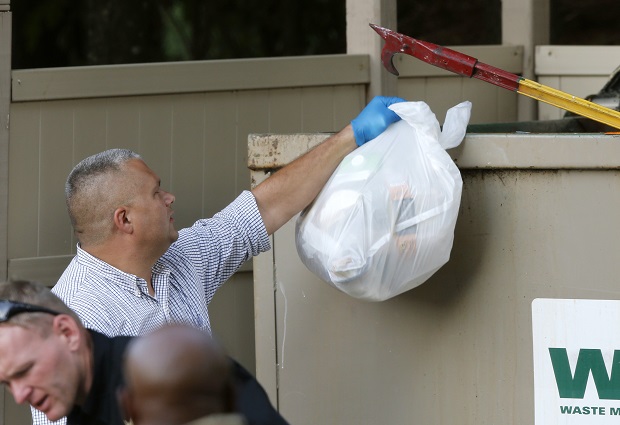Despite volatility, on-air rampage difficult to predict

Investigators search garbage from a dumpster near the apartment of Vester Lee Flanagan II in Roanoke, Va., Wednesday, Aug. 26, 2015. Flanagan filmed himself gunning down a WDBJ-TV reporter and cameraman during a live broadcast Wednesday and posted the video on social media after fleeing the scene. AP
ROANOKE, Virginia — Living alone in a world of perceived slights, Vester Lee Flanagan II never quite crossed the line from being just another angry guy to doing something that would have prevented him from buying the gun he used to kill two former co-workers on live TV in Virginia.
Flanagan, 41, had never been arrested for a felony and had no criminal record. There are no records indicating he was ever committed for psychiatric care.
Hop-scotching around the country for work, he rarely stayed anywhere longer than a year and didn’t appear to socialize much. Instead, the lasting impression among those he met — whether it was co-workers or a store clerk — was for lashing out for imagined offenses that others couldn’t fathom. His family at the other end of the country, he lived alone in an apartment near the TV station that had fired him two years ago.
Video from inside his home obtained by NBC News shows a sparsely decorated apartment and a refrigerator plastered with photos of himself, including old class pictures and modeling shots that he also posted on social media.
How can anyone stop someone from carrying out a massacre when there seem to be no hints of looming violence — or no one close enough to notice?
Article continues after this advertisement“We all wish we could predict human behavior accurately all the time,” said Clint Van Zandt, a former FBI behavioral profiler. “The behavior doesn’t cross the line until he shows he presents a realistic, immediate threat to himself and others.”
Article continues after this advertisementFlanagan fatally shot himself while fleeing police and couldn’t explain why he killed WDBJ-TV reporter Alison Parker, 24, and 27-year-old cameraman Adam Ward. In a fax to ABC News, Flanagan wrote that he had been mistreated for being black and gay, and the “tipping point” was the shooting that killed nine black people at a church in Charleston, South Carolina, in June.
READ: Former broadcaster in TV shooting was a volatile, angry man
Perhaps to bring attention to his complaints after-the-fact, Flanagan — using his on-air name, Bryce Williams — posted a grisly video of himself killing Parker and Wade and sent a series of tweets complaining about the two, who often worked together on the station’s morning show. Of Parker, an intern when he was at the station ahead of his February 2013 firing, he complained she had made racist comments; of Ward, he claimed the cameraman went to the station’s HR department after working with him just a single time.
Bureau of Alcohol, Tobacco, Firearms and Explosives spokesman Thomas Faison has said Flanagan legally purchased the gun used in the slaying that also left a local economic development official injured, something that couldn’t have happened if he had prior felony convictions or a history of mental health commitments.
It’s unclear whether Flanagan had ever been treated for psychiatric problems. The people he encountered described him as unstable and with a hair-trigger temper, but no one has so far said he made threatening remarks.
Justin McLeod, who worked as reporter at WDBJ for a time with Flanagan, described him as having a “Jekyll and Hyde” personality. He was a volatile man who had trouble making friends and would get angry at the slightest perceived insult, McLeod said, yet he also stayed in Roanoke after being fired and would occasionally be seen around town.
“It was something that was truly scary,” McLeod said.
Police were called to the station when Flanagan was fired after he initially refused to leave, but he was never charged with a crime. When an officer arrived to escort him from the building, Flanagan, who was black, yelled a racial epithet and threw a cap as he exited. He pressed a wooden cross into his news director’s hand, telling him: “You’ll need this.” Roanoke police said in a statement Friday that Flanagan sat in his personal car until he received paperwork about his dismissal, then left without problems.
Mark Sichel, a New York-based psychotherapist and author, said Flanagan was a classic “injustice collector,” a person whose fragile ego leads to paranoid behavior, such as overreacting to perceived slights and creating enemy lists, as a protective mechanism.
It usually doesn’t lead to physical violence, but as the list grows, so does the person’s rage and sense of moral superiority, Sichel said. Intervention rarely works, as such a person scoffs at therapy and rejects offers of help. These people tend to alienate people they know, but their behavior tends to be dismissed unless they threaten or harm someone.
READ: On-air shooter threatened to make ‘headlines,’ showed anger
“They could call the police and say this person is a danger to others, but I’m not sure the police could do anything,” Sichel said.
Sichel said Adam Lanza, who killed 27 people, including 20 students at Sandy Hook Elementary School, in Newtown, Connecticut, in 2012, also fit the profile. And the phrase “injustice collector” appears in an FBI report on threat assessments prepared in response to the 1999 Columbine High School massacre in Littleton, Colorado, perpetrated by teenage gunmen Eric Harris and Dylan Klebold.
Others crossed Flanagan in seemingly mundane incidents after his firing. In one instance, he wrote a rambling letter to a restaurant, complaining that staff told him “have a nice day” instead of “thank you.” In another, a co-worker at a health insurance company’s call center, Michelle Kibodeaux, 46, said he tried to grab her after she made an innocuous remark about him being unusually quiet one day.
“He said, ‘Don’t you walk away from me. Don’t you turn your back on me,'” she recalled.